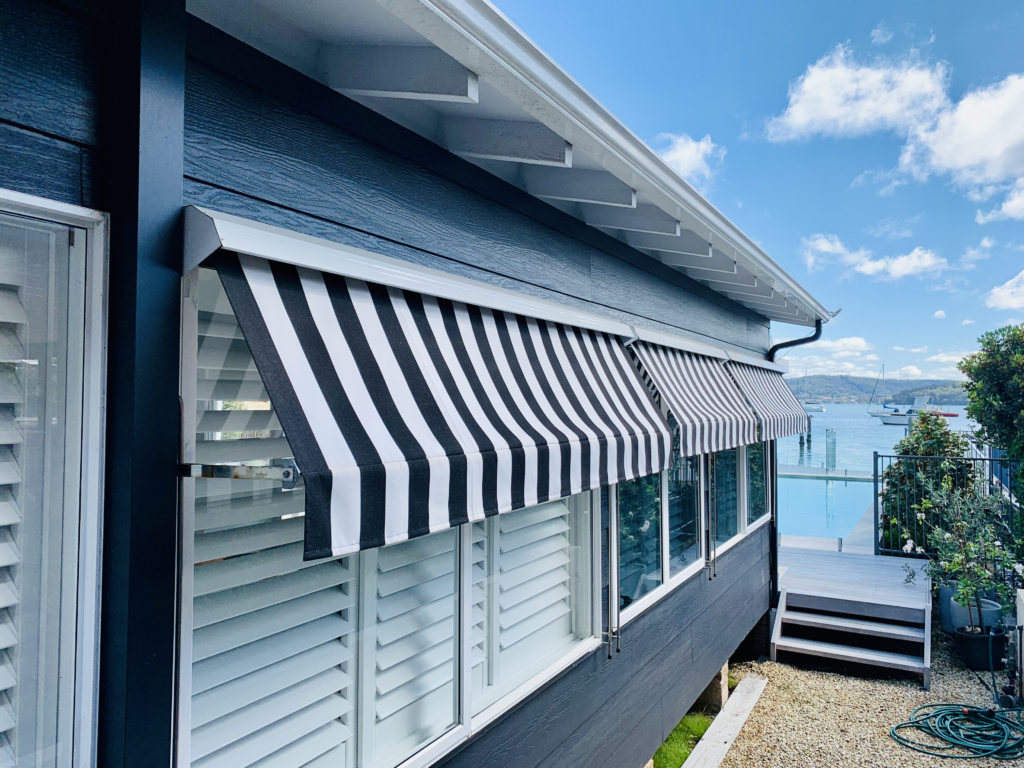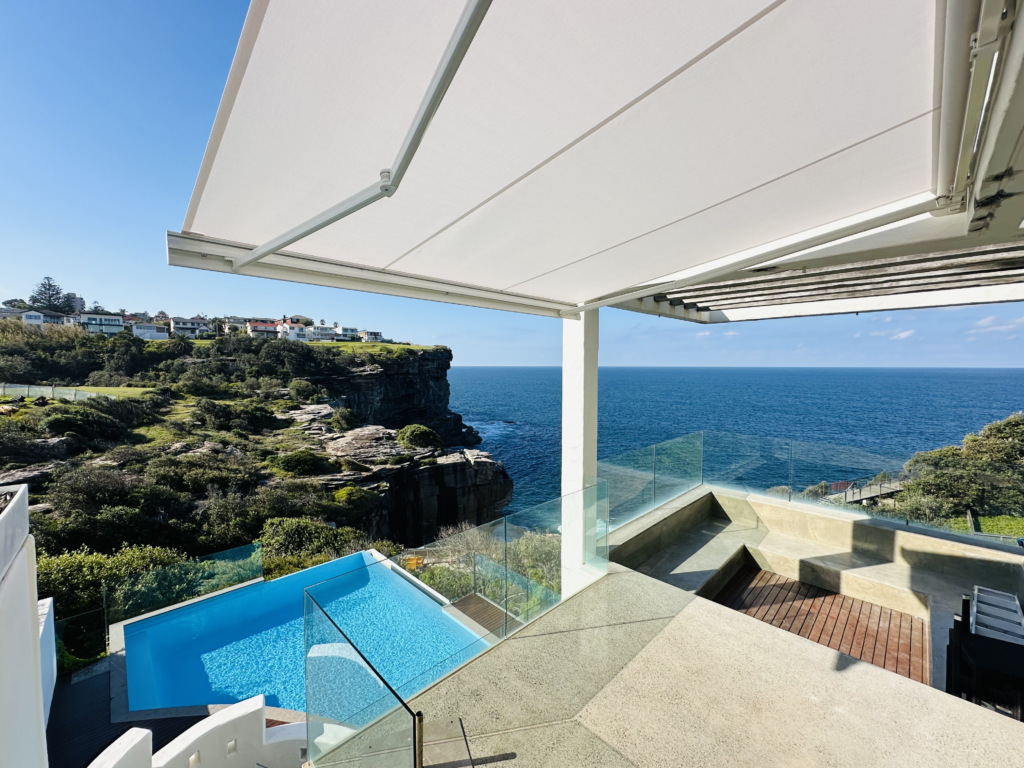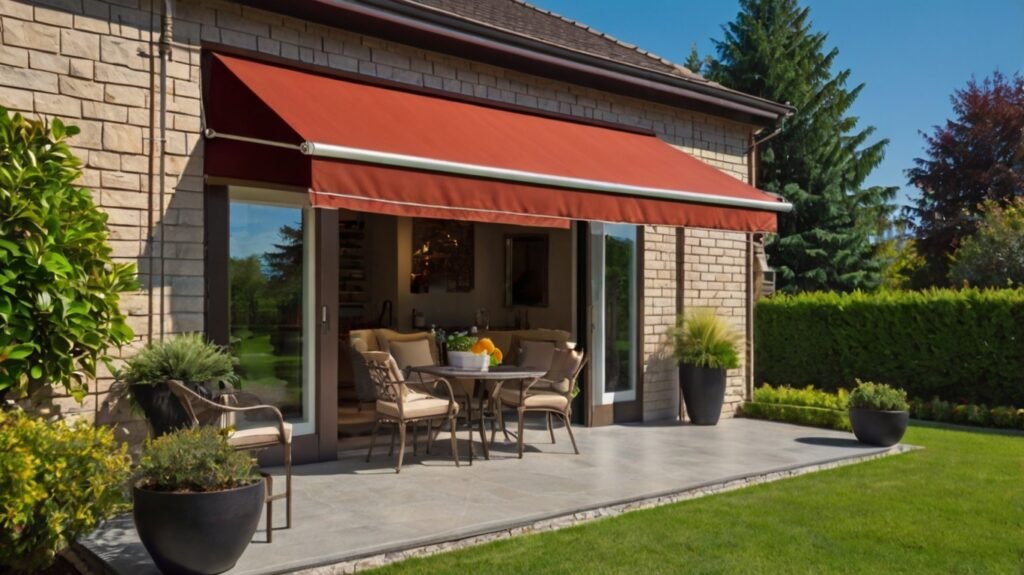Introduction: The Awning Advantage
G’day, fellow Aussies! If you’re scratching your head wondering whether those fabric or metal contraptions hanging over windows and patios can actually boost your property’s value, you’ve come to the right place. Awnings might seem like a simple addition to your home, but they pack quite a punch when it comes to both form and function.
In this comprehensive guide, we’ll dive deep into the world of awnings and explore their impact on property value. We’ll look at everything from energy savings to aesthetic appeal, and by the end, you’ll be armed with all the info you need to make a smart decision for your home. So, grab a cuppa and let’s get stuck into it!
What Are Awnings?
Before we get too far ahead of ourselves, let’s start with the basics. What exactly are awnings?
Awnings are exterior coverings attached to the outside wall of a building, typically above windows, doors, or outdoor areas. They’re like the eyelids of your house, protecting it from the harsh Aussie sun and other elements. Made from various materials such as fabric, metal, or polycarbonate, awnings serve both practical and aesthetic purposes.
“Awnings are the unsung heroes of home improvement. They work tirelessly to keep your home cool, your energy bills low, and your outdoor spaces usable,” says Sarah Thompson, a Sydney-based property stylist.
Types of Awnings
Now that we know what awnings are, let’s explore the different types you might come across in the Australian market:
Automatic Awnings
These high-tech options can extend or retract automatically based on sunlight or weather conditions. They’re perfect for busy homeowners who want convenience and optimal sun protection without constant manual adjustment.

Pivot Arm Awnings
Pivot arm awnings use arms that pivot from the side to extend the awning outward. They’re great for windows and smaller spaces, providing excellent shade while allowing for airflow underneath.
Folding Arm and Retractable Awnings
These versatile awnings can be extended when needed and folded away when not in use. They’re ideal for patios and decks, offering flexibility in managing outdoor spaces.

Wire Guide Awnings
Using a wire guide system, these awnings provide stability and a sleek look. They’re excellent for windy areas and can be used on windows or smaller outdoor areas.
Fixed Cafe Blinds and Dutch Hoods
Popular for commercial spaces but also used in homes, these fixed awnings add a touch of European charm. Cafe blinds can be rolled up, while Dutch hoods provide a permanent decorative element.
Straight Drop Awnings
These awnings drop straight down from a roller, providing excellent sun protection for windows or outdoor areas. They’re simple, effective, and can be motorized for easy operation.
Sundream Awnings
While I’m not familiar with this specific brand, it likely refers to a particular style or brand of awning popular in Australia. It’s always worth exploring local brands for options tailored to our unique climate.

Retractable Roofs
These larger systems can cover entire patios or outdoor living areas. They offer the ultimate in flexibility, allowing you to enjoy your outdoor space in any weather.
Each type of awning has its own advantages, and the best choice depends on your specific needs, home layout, and personal preferences. Whether you’re looking to shade a window, cover a patio, or create an adaptable outdoor living space, there’s an awning type to suit your requirements.
“The variety of awning types available today means homeowners can find a perfect match for both their functional needs and aesthetic preferences,” notes Emma Thompson, a Perth-based interior designer. “It’s no longer a one-size-fits-all market.”
When considering which type of awning to install, think about factors like:
- The area you want to cover
- How often you’ll want to adjust the awning
- Your local weather conditions
- The architectural style of your home
- Your budget for both purchase and ongoing maintenance
By choosing the right type of awning for your situation, you can maximize both the functional benefits and the potential increase in your property’s value.
The Impact of Awnings on Property Value
Now, let’s get to the meat and potatoes of the matter: do awnings actually increase property value? The short answer is yes, they can. But like most things in life, it’s not quite that simple.
Awnings can boost your property value in several ways:
- Energy efficiency improvements
- Enhanced curb appeal
- Additional functional outdoor space
- Protection for your home’s exterior
Let’s break these down one by one.
Energy Efficiency and Cost Savings
One of the biggest ways awnings can add value to your home is through energy savings. In our sun-drenched country, keeping cool is a constant battle, and your air con often bears the brunt of it.
Awnings act like a shield, blocking out the sun’s rays before they hit your windows. This can significantly reduce the amount of heat entering your home, which means your air con doesn’t have to work as hard. The result? Lower energy bills and a more comfortable home.
“In my experience, homes with well-placed awnings can see a reduction in cooling costs of up to 25%,” notes Peter Johnson, an energy efficiency consultant from Brisbane.
These energy savings don’t just benefit you while you’re living in the home. They can be a major selling point if you decide to put your property on the market. In an age where energy efficiency is increasingly important to buyers, awnings can give your home a competitive edge.
Aesthetic Appeal and Curb Value
Let’s face it, first impressions count. When it comes to property value, curb appeal plays a huge role. It’s like dressing up for a first date – you want to make a good impression right off the bat.
Awnings can be a game-changer in this department. They add depth, colour, and character to your home’s exterior. Whether you opt for classic stripes, bold solids, or elegant patterns, awnings can transform a plain facade into something eye-catching and inviting.
Think of awnings as the accessories that complete your home’s outfit. Just as a stylish hat or a smart pair of shoes can elevate an entire ensemble, well-chosen awnings can take your home’s exterior from “meh” to “wow!”
But it’s not just about looks. The added curb appeal can translate directly into dollars when it comes time to sell. Many real estate agents agree that homes with strong curb appeal tend to sell faster and for higher prices.
Functionality and Additional Living Space
In Australia, we love our outdoor living. From backyard barbies to morning coffees on the veranda, we’re always looking for ways to make the most of our outdoor spaces. This is where awnings really shine (or rather, provide shade).
By installing awnings over patios, decks, or even sections of your yard, you’re essentially creating additional living space. These areas become usable even in the height of summer or during light rain, effectively extending your home’s functional square footage.
“Outdoor living areas are a huge selling point in the Aussie market,” says Emma Lewis, a real estate agent from Melbourne. “Homes with well-designed outdoor spaces protected by awnings often command higher prices because buyers see the value in that extra usable space.”
This added functionality can be a major drawcard for potential buyers, potentially increasing your property’s value. After all, who wouldn’t want a home that offers more bang for their buck?
Considerations Before Installing Awnings
Before you rush out to install awnings on every available surface, there are a few things to consider:
Quality Matters
Not all awnings are created equal. Cheap, poorly made awnings can detract from your home’s appearance and may need frequent replacing. Invest in quality materials and professional installation for the best results.
Design Harmony
Choose awnings that complement your home’s architectural style. An ultra-modern awning on a Federation-style home might look out of place, potentially decreasing rather than increasing value.
Local Climate
Consider your local weather patterns. While awnings are great for sun protection, areas prone to high winds might require specially designed or retractable options.
Council Regulations
Check with your local council before installation. Some areas have restrictions on awning size, style, or placement, especially for heritage-listed properties.
Future Maintenance
Factor in the ongoing care your awnings will need. Some materials require more upkeep than others, which could impact their long-term value addition.
Maintenance and Longevity
Speaking of maintenance, let’s dive a bit deeper into this aspect. The longevity of your awnings plays a crucial role in their ability to add value to your property over time.
Fabric awnings typically need more frequent care. They should be cleaned regularly to prevent mould and mildew growth, especially in humid areas. You’ll also need to keep an eye out for any tears or loose seams.
Metal awnings, on the other hand, are generally more durable and require less maintenance. A occasional wipe-down and check for rust spots is usually sufficient.
Retractable awnings, whether manual or motorised, have moving parts that may need lubrication or replacement over time. However, their ability to be tucked away during harsh weather can extend their overall lifespan.
“Proper maintenance can double or even triple the life of your awnings,” advises Tom Baker, a home maintenance expert from the Gold Coast. “It’s a small investment of time that pays off in the long run.”
Remember, well-maintained awnings not only last longer but also continue to look good year after year, maintaining their positive impact on your property’s value.
Cost vs. Value: Is It Worth It?
Now, let’s talk dollars and cents. Are awnings a worthwhile investment when it comes to increasing property value?
The cost of awnings can vary widely depending on the type, size, material, and whether you opt for professional installation. As a rough guide, you might be looking at anywhere from a few hundred dollars for a small, simple awning to several thousand for a large, motorised system.
But here’s the thing: the value awnings add to your home isn’t just about the potential increase in sale price. It’s also about:
- The energy savings over time
- The added comfort and usability of your home
- The protection they provide to your windows and exterior walls
- The potential appeal to future buyers
When you factor in all these benefits, awnings often prove to be a sound investment. Plus, unlike some home improvements that go out of style, awnings have been adding value to homes for decades and are likely to continue doing so.
Conclusion
So, do awnings increase property value? The evidence suggests that yes, in most cases, they do. From energy savings and aesthetic appeal to additional living space and protection for your home, awnings offer a range of benefits that can boost your property’s value.
However, it’s important to approach awning installation thoughtfully. Consider your home’s style, your local climate, and your long-term maintenance commitment. Choose quality products and professional installation to ensure you’re adding value, not creating future headaches.
Remember, the true value of awnings extends beyond just dollars. They can enhance your daily living experience, making your home more comfortable, energy-efficient, and enjoyable. And when it comes time to sell, these benefits can translate into a more attractive property for potential buyers.
So, if you’re on the fence about awnings, why not give them a go? They might just be the upgrade your home needs to take it to the next level. After all, in the great Aussie tradition, why not throw some shade… on your house?
FAQs
1. How much can awnings reduce my energy bills?
Awnings can reduce cooling energy consumption by 26% in hot climates like much of Australia, according to some studies. However, actual savings depend on factors like awning placement, local climate, and your home’s overall energy efficiency.
2. Are retractable or fixed awnings better for property value?
Both can add value, but retractable awnings often have a slight edge due to their flexibility. They allow homeowners to adjust for changing weather conditions and preferences.
3. What’s the average lifespan of an awning?
With proper care, fabric awnings typically last 5-15 years, while metal awnings can last 20-30 years or more. However, this can vary based on climate, usage, and maintenance.
4. Can I install awnings myself to save money?
While DIY installation is possible for some simple awnings, professional installation is recommended for most types, especially motorised or large awnings. Proper installation ensures safety, functionality, and longevity.
5. Do awnings work in winter too?
Yes, awnings can provide benefits year-round. In winter, they can be retracted to allow sunlight in for natural heating, or extended to protect against winter storms.
6. Are there any downsides to installing awnings?
Potential downsides include maintenance requirements, the risk of wind damage in some areas, and the possibility of blocking views if not carefully placed. However, these can usually be mitigated with proper planning and care.
7. How do I choose the right colour for my awnings?
Choose a colour that complements your home’s exterior and fits with the overall neighbourhood aesthetic. Neutral colours often have the broadest appeal if you’re considering future resale value.
8. Can awnings be used for advertising my business?
In some areas, yes. However, check local regulations as there may be restrictions on using awnings for advertising, especially in residential areas.
9. Do awnings require council approval?
This varies by location. Some councils require approval for awnings, especially for larger installations or in heritage areas. Always check with your local council before installation.
10. How often should I clean my awnings?
For fabric awnings, a thorough cleaning every 6-12 months is usually sufficient, with spot cleaning as needed. Metal awnings may need less frequent cleaning, but should be inspected regularly for any signs of rust or damage.

